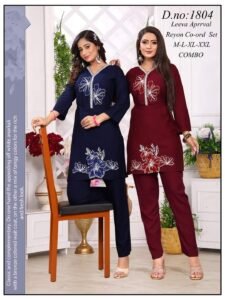Kurtis have become a global fashion phenomenon, blending traditional elegance with contemporary trends. Whether you’re dressing for a casual outing, a formal event, or a festive celebration, a well-styled kurti can elevate your look effortlessly.

By the end of this post, you’ll be a kurti styling expert!
1. The History and Evolution of Kurtis
Kurtis trace their origins back to the Mughal era, where they were influenced by Persian and Central Asian attire. Originally, they were long, flowing garments worn by both men and women. Over time, kurtis evolved into a women-centric fashion staple, adapting to modern tastes while retaining ethnic charm.
Key Milestones in Kurti Fashion:
- Ancient Times: Long, straight-cut kurtas worn with churidars or lehengas.
- Colonial Era: Fusion with British styles led to shorter lengths and fitted designs.
- Post-Independence: Bollywood popularized kurtis in the 1960s-70s.
- 2000s to Present: Western influences introduced asymmetric cuts, Indo-Western fusion, and ready-to-wear styles.
2. Different Types of Kurtis & Their Unique Styles
Kurtis come in various cuts, lengths, and designs. Here’s a breakdown of the most popular types:
A. Anarkali Kurtis
- Features: Flared, floor-length design inspired by Mughal fashion.
- Best For: Weddings, parties, and festive occasions.
- Styling Tip: Pair with churidar pants and statement jewelry.
B. Straight Cut Kurtis
- Features: Simple, straight silhouette ending at the hip or knee.
- Best For: Office wear, casual outings.
- Styling Tip: Wear with leggings or palazzos for a chic look.
C. A-Line Kurtis
- Features: Fitted at the top and flared at the bottom.
- Best For: Daily wear, semi-formal events.
- Styling Tip: Accessorize with a belt to accentuate the waist.
D. Asymmetrical Kurtis
- Features: Uneven hemlines for a modern twist.
- Best For: Trendy, fashion-forward looks.
- Styling Tip: Pair with fitted jeans or dhoti pants.
E. Angrakha Kurtis
- Features: Overlapping front panels inspired by royal attire.
- Best For: Traditional events and cultural gatherings.
- Styling Tip: Combine with a dupatta for an elegant touch.
F. Shirt Style Kurtis
- Features: Button-down design resembling a shirt.
- Best For: Office wear, brunches.
- Styling Tip: Tuck into trousers for a polished look.
3. Best Fabrics for Kurtis
Choosing the right fabric enhances comfort and style. Here are the top picks:
| Fabric | Best For | Pros | Cons |
|---|---|---|---|
| Cotton | Summer, Casual Wear | Breathable, lightweight | Wrinkles easily |
| Silk | Weddings, Festivals | Luxurious, shiny | High maintenance |
| Linen | Office, Travel | Wrinkle-resistant, durable | Slightly rough texture |
| Chiffon | Parties, Evening Wear | Flowy, elegant | Delicate, requires care |
| Georgette | Festive, Formal | Drapes well, lightweight | Can be sheer |
| Rayon | Daily Wear | Soft, affordable | Less durable |
4. How to Style Kurtis for Different Occasions
A. Office Wear
- Kurti Type: Straight-cut or shirt-style.
- Bottom Pairing: Trousers or pencil pants.
- Accessories: Minimal jewelry, a sleek handbag.
B. Casual Outings
- Kurti Type: A-line or asymmetrical.
- Bottom Pairing: Jeans or palazzos.
- Accessories: Sneakers, sunglasses, tote bag.
C. Festive & Wedding Looks
- Kurti Type: Anarkali or embroidered kurti.
- Bottom Pairing: Lehenga skirt or churidar.
- Accessories: Jhumkas, bangles, embellished clutch.
D. Indo-Western Fusion
- Kurti Type: Crop top kurti or dhoti-style.
- Bottom Pairing: Dhoti pants or culottes.
- Accessories: Oxidized jewelry, kolhapuri chappals.
5. Latest Kurti Trends in 2025
Stay ahead with these trending styles:
✅ Bold Prints – Animal prints, abstract designs.
✅ Sheer Layers – Transparent overlays for a glam look.
✅ High-Low Hemlines – Playful and stylish.
✅ Cape Kurtis – Adds drama and elegance.
✅ Pastel Shades – Soft hues for a subtle charm.
6. Q&A – Answering Common Kurti Questions
Q1. What is the ideal length for a kurti?
A: Depends on body type and occasion:
- Petite women: Knee-length or shorter.
- Tall women: Ankle-length or long Anarkalis.
- Casual wear: Hip to knee-length.
- Formal wear: Calf-length or full-length.
Q2. Can I wear a kurti without a dupatta?
A: Yes! Dupattas are optional. For a modern look, skip it or replace it with a belt or scarf.
Q3. How do I choose the right neckline for my kurti?
A:
- Round neck: Universal fit.
- V-neck: Elongates the neck.
- High neck: Best for slim faces.
- Square neck: Adds structure.
Q4. What footwear goes best with kurtis?
A:
- Ethnic: Juttis, mojris.
- Casual: Flats, kolhapuris.
- Formal: Block heels, wedges.
Q5. How can I make my kurti look more stylish?
A:
- Add a belt for definition.
- Layer with a jacket or shrug.
- Experiment with statement jewelry.
Conclusion
Kurtis are versatile, timeless, and endlessly stylish. Whether you prefer traditional Anarkalis or trendy asymmetrical cuts, there’s a perfect kurti for every occasion. By understanding fabrics, styles, and pairing techniques, you can create stunning looks effortlessly.
Which kurti style is your favorite? Share in the comments!



